Rotary Mowers Safety: Lawncare Training Guide
ID
BSE-47P (BSE-315P)
Mower Care and Safe Use
Mowing lawns continues to be one of the most popular summer job opportunities for youth given the affordable cost and ease in operation of most rotary mowers. However, easy access and widespread use of mowers often creates a false sense of security among the users of these machines. Data from a seven-year period showed the highest rate of hospitalization from lawn mower injuries was for youth workers ages 15 to 19. The Consumer Product Safety Commission reported that more than 37,000 riding mower injuries occurred from 2003 through 2005 alone. During the same period, there were 95 fatalities due to riding mower tip-over. The purpose of this training guide is to reduce the number of mower accidents and injuries by familiarizing young workers with rotary mowers and their safe operation.

Mower Types
A standard lawn mower comes with a single cutting blade that can provide a 12- to 22-inch-wide cut. Larger self-propelled units and riding mowers are generally designed for cutting wider swaths of 36 to 72 inches. Many of these units are designed to serve as garden tractors that can be outfitted with attachments for hauling small loads and to perform operations such as tilling, aeration, snow removal, and spreading fertilizers and chemicals. Front-mounted zero-turning-radius mowers, in particular, come with a variety of other implements that can be attached and detached for landscape-related operations.
Regardless of the size of the rotary mower, during mowing the plant material is cut when the metal blade mounted on a rapidly spinning shaft (typically 2,000- 2,500 revolutions per minute) comes in contact with the vegetation under the enclosed housing (the mower deck). The mower blade generally comes with a bend opposite to the sharpened edge (3- to 4-inch-long area from the blade tip extending toward the center) known as an “up sail.” This creates airflow under the deck to direct the cut material to a deck discharge and/or to hit the cut plant material multiple times in the case of a mulching mower.
While a common term for mowing is “cutting grass,” more precisely, the mower blade tears the plant foliage as it strikes the stationary plant tissue. The quality of the cut depends on the sharpness of the blade and how well it is balanced. The following are the three basic requirements, recommended by TORO University’s “Rotary Mower Basics,” for best mower performance:
- The blade must be straight with sharp cutting edges.
- The blade must have the proper attitude in relation to the ground surface.
- The blade must rotate at the proper speed with respect to mower groundspeed.
The deck and blade designs vary depending on how the plant and other materials under the mower deck are to be discharged. Side- or rear-discharge decks are most common. The rear-discharge decks are generally preferred for mowing areas where people might be nearby.

Mower deck designs for zero discharge are becoming more common. This design chops the vegetation into finer bits and drops them into the canopy as the mower passes over. The advantages of these mulching mowers are efficient recycling of clippings and improved safety because bystanders will not be hit by flying debris.
Major Components and Operation
This section of the training guide includes a general description of major components of rotary mowers. For specifications and additional details, readers may depend on an operator’s manual.
Power Unit
Rotary push mowers with and without self-propelling drive are typically powered by 4- to 8-horsepower gasoline engines. Most cut a 21- or 22-inch swath. These mowers can handle long or thick grass and weeds, and can bag, side-discharge, or mulch clippings. Although most mowers are powered by four-cycle engines, a few are powered by two-cycle engines or by electric motors.

Self-propelled models are the best for most lawns and they have become more popular in recent years because of their improved performance and ease in operation. These models with either front- or rear- wheel drive use higher-capacity engines and heavier frames.

Commercial walk-behind mowers are generally powered by 16- to 25-horsepower engines with a battery starter. They use either gear or hydrostatic transmission systems for transmitting power, and they have the capacity to cut swaths 32- to 60-inches wide. They generally are equipped with a heavy-duty frame and four-ply turf tires. Commercial walk-behind mowers are designed to offer reliable performance for landscapers and owners of large lots.
The self-propelled riding mowers used in lawn care may be placed in one of the following two categories:
- Riding lawn mowers (8-25 horsepower) fitted with a mower deck. Usually these have no attachments.
- Lawn and garden or compact tractors (12-60 horsepower) come with mower decks and other attachments. Engines on these tractors are either gasoline or diesel, and they may be either air- or liquid-cooled.
Cutter Deck Housing
The deck housing supports the blade hubs with their drive mechanism and is shaped to carry the grass clippings away from the deck.
Blade Mounting and Drive System
The blades are driven directly by the engine crankshaft. Models with blades driven by hydraulic motors or by belt pulley systems are also available.

Blade
The blades have sharpened cutting edges at both ends with a curved up sail area to create airflow under the deck. This airflow will whip the grass blades up, exposing them to the blade cutting edge. The airflow also pushes the grass clippings out through the deck discharge.
Power Transmission
The three types of power transmissions available with mowers are manual-shift, variable-speed, and hydrostatic. In order to operate different types of mowers effectively, the operators should be familiar with the different types of transmissions and their operating characteristics.
The manual-shift transmissions are usually belt- or gear-driven. Belt transmissions are the simplest and cheapest and are usually found on smaller riding mowers. In most cases, a fixed-speed belt drives a 3-, 4-, or 5-speed gear transmission. Belt transmissions have the advantage of not needing a separate clutch because the belt can be slackened to provide clutching. Speed is changed by moving the belt on the side of a sheave in or out, thus changing the pitch diameter of the sheave. The second sheave is normally spring-loaded, so it responds in a direction opposite to the control sheave. Therefore, as the operator moves the speed control lever, one sheave is, in effect, made smaller while the other is made larger. This in essence changes the transmission ratio and makes the mower move faster or slower.
Gear transmission generally provides three to five forward speeds and one reverse speed. A clutch system may be used between the engine and transmission for disengaging the two when power need not be transmitted. In most small tractors, the gear transmission, axle, and differential are integrated into one unit called a “transaxle.”
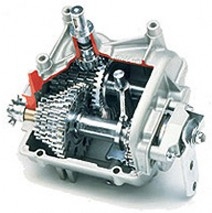
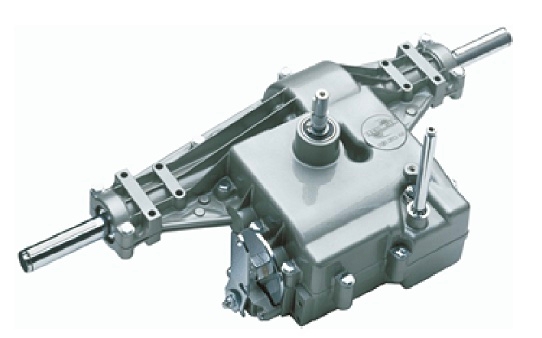
Mechanical transaxles are durable and trouble-free. While gear transmissions in general are known for their low cost and high reliability, they lack the flexibility for infinite speed control. Using a gear transmission in combination with a variable-speed belt drive will provide both cost-effectiveness and flexibility.
The hydrostatic transmission, also known as a continuously variable transmission, offers maximum flexibility in terms of speed control. The major components of such a transmission system include a variable displacement pump, a hydraulic motor, a charge pump to replenish the fluid supply, and a set of check valves. In this type of system, power is transmitted through pressurized fluid under confinement. The direction of the motor shaft rotation and its speed are controlled by the direction and quantity of pump output flow, respectively. For a given input speed, infinite output speeds within a range are possible with a hand lever or foot pedal. Other advantages associated with hydrostatic transmissions include potential for transmitting increased torque, high efficiency, compactness, flexibility in mounting the motor directly on the wheel, and easy single-hand-lever or foot-pedal control for forward and reverse speeds. The primary disadvantages of the system include high initial and maintenance costs and the difficulty of keeping the system contamination-free.
Safety Features
Walk-behind mowers are equipped with a clutch on the handle, and when it is disengaged, it quickly shuts off either the blade and/or the engine. Most riding mowers come with a “kill switch” under the seat. This switch turns off the blade and/or the engine when the opera- tor leaves the seat. Most riding mowers will not start unless the blade is disengaged. Never disable any of these important built-in safety features.


”No-Mow-in-Reverse” Controls
On average, one child is backed over by a riding mower in the U.S. every day. The biggest danger of “mowing in reverse” comes from the blind spots present on most riding mowers, especially those equipped with a large rear grass catcher. A small child (36-inches tall) playing behind the mower may not be seen by an operator from the operator’s seat.
The lawn mower industry adopted a voluntary safety standard (ANSI/OPEI B71.1-2003, revised to ANSI B71.1-2012). This standard requires a “no-mow-in-reverse” mechanism on all new mowers. However, manufacturers are permitted to install equipment that overrides this safety feature temporarily (RIO button shown above).
The no-mow-in-reverse feature shuts off the mower blades when shifted into reverse. The override device (either a button on the dash or a position on the ignition switch) allows operators to override the feature. Some mowers come with a warning on the dash to “look for children” before using the override option.
Suspension System
Most riding mower chassis suspensions are simple sys- tems that will allow the vehicle to follow the terrain and isolate the operator from shocks and vibrations. The seat suspension systems on most mowers are designed to protect the operators from low frequency vibration and reduce operator fatigue. They are adjustable based on the size of the operator, and it is a good practice to adjust them prior to using the riding mower.
Suspension Systems for Mower Decks
Two types of suspension systems are common on mowers. While suspended decks are more common on smaller mowers, ground-carried decks are more common on larger units. Both types work well; however, it is important that the operator understands the differences between the two and the adjustments for improving the performance of each.
Suspended Mower Decks
Suspended decks generally hang under the mower on a parallelogram linkage. An adjustable stop link limits the rotation of the parallel linkage and controls the deck height. The adjustable stop may be controlled by a knob or lever on the tractor. During operation, the deck is lowered until the linkage hits the stop.
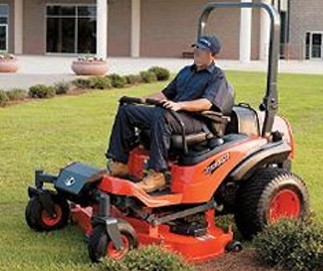
With suspended linkage, the anti-scalp wheels and rollers on the mower are not designed to contact the ground during normal operation. They are primarily there to prevent scalping on uneven ground. The height of the wheels and rollers is adjusted to match the mowing height setting chosen so that the wheels or rollers are carried just above the level ground surface.
If the anti-scalp wheels or rollers are in contact with the ground all the time, they are out of adjustment and this will result in excessive wear. For proper adjustment of these rollers and wheels, follow the recommendations in the operator’s manual.
Ground-Carried Decks
The decks on most mowers used for commercial applications are ground-carried or ground-following. The linkages on these decks are similar to the suspended linkages. However, they are not parallelogram linkages. On these tractors, the linkage lifts the mower deck for transport and pulls the deck along while mowing, without carrying the weight of the mower. With ground-carried decks, the deck rides on gauge wheels during use. The wheels are generally much larger in diameter than the anti-scalp wheels on suspended decks, and they usually have pneumatic tires.
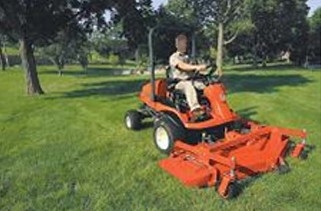
During transport, the ground-carried decks are lifted off the ground with the linkage. The front linkage, rear linkage, or both will pull the mower deck along while mowing, and the mower will follow the contours of the ground, independent of the chassis. Height adjustment is accomplished by adjusting the gauge wheels or rollers. Review the operator’s manual for recommendations on setting of wheels and rollers.
Tires
Prior to use, the tires on mowers should be checked daily. Maintaining recommended inflation pressure is extremely important for extending the life of tires. If an operator’s manual is not readily available to get the recommended inflation pressure, one may contact the dealership or visit its website for the information.
When the tires are overinflated, the ride will be rough and a smaller portion of the tire will be in contact with the ground. This situation causes excessive wheel slippage and wear in the middle of the tire. Underinflation, on the other hand, results in rim slippage and loss of air pressure. It could also result in sidewall buckling and excessive sidewall wear. Proper inflation pressure will provide a larger wheel-soil contact area, better traction, and even wear patterns.
Zero-Turn Mowers
Zero-turning-radius mowers use a dual hydraulic system to take 180 degree (ZTR) turns quickly and easily. These mowers are capable of covering large areas in less time and mowing in close proximity to different objects in and around the landscape. Three types of ZTR mowers are available: front-mount, mid-mount, and rear-mount. The front-mount ZTR mowers have their cutting deck in front of the operator. They are generally more stable than the other types, and they make mowing around obstacles comparatively easier. They also work well on slopes. For these reasons, the front-mount ZTR mowers are more popular than the other two types.

The mid-mount ZTR mowers have their decks mounted directly below the operator. The primary advantage of this type of mower is that it takes up less space during transport and storage because of its shorter body length. On rear-mount ZTR mowers, the cutting deck will be behind the operator.
Safe Use of Mowers
Safety when using mowers can be improved significantly by purchasing the right kind of mower for the job. When shopping for a new push or riding mower, make sure that they meet the established safety standards. The current standards guarantee certain safety features such as automatic disengagement of blade when the mower is stopped, when the operator leaves the seat, or when the mower is in reverse. This automatic cutoff will be helpful in reducing the number of accidents and associated injuries. These standards also give guidelines for better safety systems to improve vehicle stability and protect the operator.
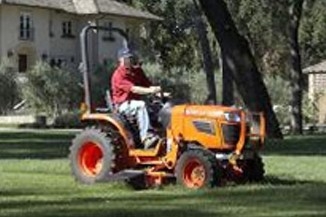
Mowing safety also depends on how experienced the operator is and how familiar he or she is with the equipment. The operator’s manual is extremely helpful in getting familiar with the equipment. The manual also provides maintenance and safety information. Therefore, repeated review of the manual by the operator is highly recommended to make the mowing operation safer.
To properly fill a fuel container.

- Set the container on the ground.
- Touch the nozzle to the container before removing the container lid (removes static electricity).
- Keep the nozzle in contact with the container while filling.
- Don’t fill to the brim. Leave room for expansion.
- To reduce the chance of static sparks, do not fill containers in the bed of a pickup or in a car.
In addition to these, there are a number of other precautionary measures the operator can take to improve mower safety, and they are as follows:
During mowing, wear all the required personal protective equipment stated in the operator’s manual. In particular, pay attention to protective devices for the eyes, ears, and all extremities.
Ensure that all shields and guards are in place and functioning. Never remove shields to increase clipping discharge or for any other reasons.
Before operating a riding mower or a ZTR mower, make multiple practice runs without engaging the blade to ensure that the operator can handle the equipment safely.
Make sure the riding or ZTR mower in use is equipped with seat belts and rollover protection structures.
Strictly follow guidelines in the operator’s manual.
Disconnect the spark plugs before any mower maintenance activities, such as blade sharpening, balancing, and adjusting.
To avoid the binding of the mower blades and to improve grass health, do not remove more than one-third of the leaf blade during any single mowing.
Prior to mowing, check the area for toys, trash, landscape debris, exposed rock, wires, or irrigation heads, and remove and/or mark them to avoid damage.
Operate the mower at the recommended engine speed.
Discharge clippings away from bystanders or doorways.
Keep hands and feet away from the spinning blades at all times.
When operating push mowers, wear shoes that optimize traction.
Avoid mowing wet grass, particularly on slopes, for better shoe and wheel traction.
Turn off the mower engine before unclogging the discharge chute.
Never leave a running mower unattended.
To prevent possible injury from flying debris, wear heavy steel-toed shoes and long pants when operating a push mower.
Slow down and maintain control when operating a riding mower on rough terrain.
Do not allow any additional riders on riding mowers.
Use a funnel when refueling a warm engine. (Add fuel on a flat surface, preferably off the lawn.)
Maintain proper speeds and avoid sharp turns to prevent tip-over.
Mow up and down the slopes and not across to avoid overturning sideways when using a riding mower. Mow across the slopes with a push mower to avoid a runaway situation. For ZTR mowers, follow the recommendations in the operator’s manual.

Stay clear of ditches and embankments. If a ditch is 6 feet deep, the rule of thumb is that the riding mower should not be any closer than 6 feet from the edge of the embankment to avoid embankment failure.
Be careful when backing up riding mowers. Watch especially for young children when backing up.
Do not operate a riding mower under the influence of drugs or alcohol. Do not use cell phones or music listening devices while mowing.
Do not operate a mower while fatigued.
Follow the manufacturer’s recommendations for wheel weights or counterweights on riding mowers.
Follow general safety tips for outdoor work; protect yourself from heat stress, solar radiation, dehydration, and insect bites.
Check the area to be mowed and remove loose and/or hidden objects before mowing.
Safe Transport of Riding Mowers
In addition to following the recommendations in operator’s manuals, the following steps may help ensure safe transportation of riding mowers:
Keep bystanders at a safe distance.
Block the rear wheels of the transport vehicle.
Attach appropriate ramps to the transport vehicle before loading.
Chain and block the riding mower to avoid movement during transport.
Back the mower up the ramp. To unload, drive forward down the ramp.

Resources
American National Standard Institute. 2012. Commercial Turf Care Equipment – Safety Specifications. ANSI/OPEI B71.4-2012. New York: ANSI.
American National Standards Institute. 2012. Consumer Turf Care Equipment – Pedestrian-Controlled Mowers and Ride-On Mowers – Safety Specifications. ANSI B71.1-2012, New York: ANSI.
Costilla, V., and D. M. Bishai. 2006. “Lawnmower Injuries in the United States: 1996 to 2004.” Annals of Emergency Medicine 47:567-73. doi:10.1016/j. annemergmed.2006.02.020.
Lind, S., and M. Ricketts. 2009. Mowing and Trimming Safety: For the Landscaping and Horticultural Services Industry. K-State Research and Extension. Publication MF 2714 rev., Manhattan, KS: Kansas State Research and Extension. https://bookstore.ksre.ksu.edu/pubs/MF2714.pdf
Parish, R. L. 2008. Zero Turning Radius Mowers: Selection, Use, Maintenance, Safety. Louisiana State University Agricultural Center. Publication 2911.
Smith, D. W. 2011. Lawn Maintenance Safety. Texas A&M AgriLife Extension. Publication E-356.
Toro University. 2010. Rotary Mower Basics. TORO University Technical Training Manual. Part No. 09167SL. Bloomington, MN: The Toro Company.
U.S. Consumer Product Safety Commission. 2013. Riding Lawnmowers. CPSC Fact Sheet. Publication 588.
Acknowledgments
This publication was developed with the support of the National Youth Farm Safety Education and Certification Program (Grant No. USDA/ NIFA-2010-41521-20830), the National Institute of Food and Agriculture, and the U.S. Department of Agriculture. The team that developed this publication is solely responsible for its content, and it does not necessarily reflect the views of the USDA or the U.S. Department of Labor. Team members are Robert Grisso, John Perumpral, Don Ohanehi, Mike Goatley, Kathleen Jamison, Cathy Sutphin, Dan Swafford, and Carl Estes.
The authors are grateful to the following for permission to use their pictures and diagrams: Kansas State University, Kubota Tractor Corp., Exmark Manufacturing Co., DR Power Equipment, The Toro Company, Instructables.com, and Mike Goatley Jr.
Virginia Cooperative Extension materials are available for public use, reprint, or citation without further permission, provided the use includes credit to the author and to Virginia Cooperative Extension, Virginia Tech, and Virginia State University.
Virginia Cooperative Extension is a partnership of Virginia Tech, Virginia State University, the U.S. Department of Agriculture, and local governments. Its programs and employment are open to all, regardless of age, color, disability, sex (including pregnancy), gender, gender identity, gender expression, national origin, political affiliation, race, religion, sexual orientation, genetic information, military status, or any other basis protected by law
Publication Date
January 29, 2024



